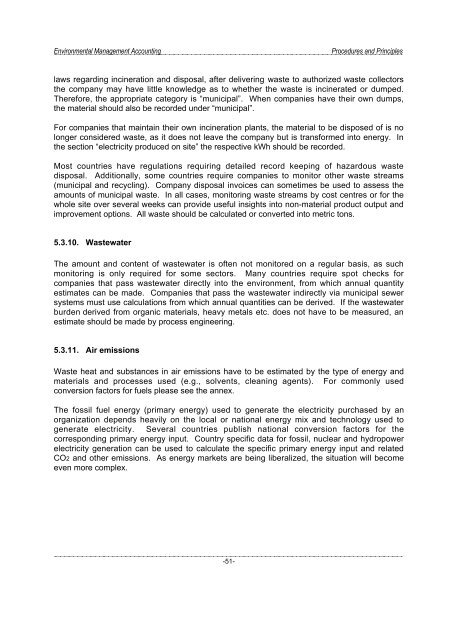Environmental Management Accounting Procedures and Principles
Environmental Management Accounting Procedures and Principles
Environmental Management Accounting Procedures and Principles
Create successful ePaper yourself
Turn your PDF publications into a flip-book with our unique Google optimized e-Paper software.
<strong>Environmental</strong> <strong>Management</strong> <strong>Accounting</strong><br />
<strong>Procedures</strong> <strong>and</strong> <strong>Principles</strong><br />
laws regarding incineration <strong>and</strong> disposal, after delivering waste to authorized waste collectors<br />
the company may have little knowledge as to whether the waste is incinerated or dumped.<br />
Therefore, the appropriate category is “municipal”. When companies have their own dumps,<br />
the material should also be recorded under “municipal”.<br />
For companies that maintain their own incineration plants, the material to be disposed of is no<br />
longer considered waste, as it does not leave the company but is transformed into energy. In<br />
the section “electricity produced on site” the respective kWh should be recorded.<br />
Most countries have regulations requiring detailed record keeping of hazardous waste<br />
disposal. Additionally, some countries require companies to monitor other waste streams<br />
(municipal <strong>and</strong> recycling). Company disposal invoices can sometimes be used to assess the<br />
amounts of municipal waste. In all cases, monitoring waste streams by cost centres or for the<br />
whole site over several weeks can provide useful insights into non-material product output <strong>and</strong><br />
improvement options. All waste should be calculated or converted into metric tons.<br />
5.3.10. Wastewater<br />
The amount <strong>and</strong> content of wastewater is often not monitored on a regular basis, as such<br />
monitoring is only required for some sectors. Many countries require spot checks for<br />
companies that pass wastewater directly into the environment, from which annual quantity<br />
estimates can be made. Companies that pass the wastewater indirectly via municipal sewer<br />
systems must use calculations from which annual quantities can be derived. If the wastewater<br />
burden derived from organic materials, heavy metals etc. does not have to be measured, an<br />
estimate should be made by process engineering.<br />
5.3.11. Air emissions<br />
Waste heat <strong>and</strong> substances in air emissions have to be estimated by the type of energy <strong>and</strong><br />
materials <strong>and</strong> processes used (e.g., solvents, cleaning agents). For commonly used<br />
conversion factors for fuels please see the annex.<br />
The fossil fuel energy (primary energy) used to generate the electricity purchased by an<br />
organization depends heavily on the local or national energy mix <strong>and</strong> technology used to<br />
generate electricity. Several countries publish national conversion factors for the<br />
corresponding primary energy input. Country specific data for fossil, nuclear <strong>and</strong> hydropower<br />
electricity generation can be used to calculate the specific primary energy input <strong>and</strong> related<br />
CO2 <strong>and</strong> other emissions. As energy markets are being liberalized, the situation will become<br />
even more complex.<br />
-51-




